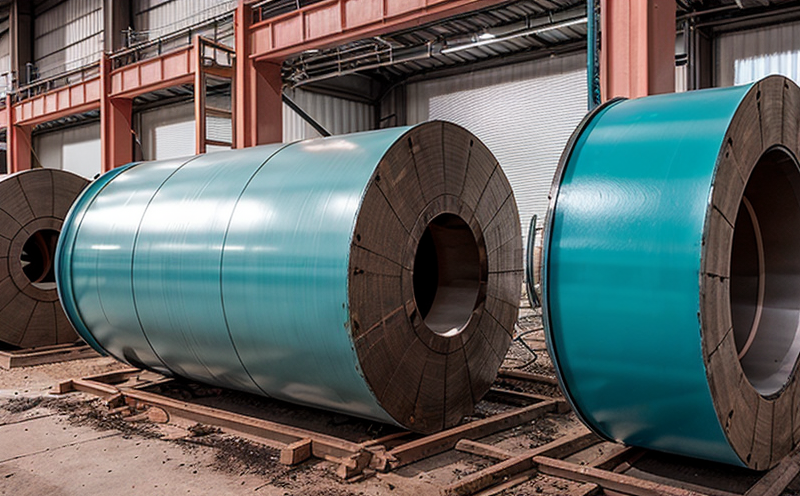DIN EN ISO 6270 Condensation Water Corrosion Testing
The DIN EN ISO 6270 standard is a comprehensive framework designed to assess the corrosion resistance of materials exposed to condensation water environments. This testing method is crucial for industrial manufacturing and processing, where the integrity of materials can significantly impact product quality and operational safety.
Condensation water forms when warm air meets cooler surfaces, leading to the formation of liquid water on these surfaces. This phenomenon is common in many industrial settings, including HVAC systems, refrigeration units, chemical plants, and food processing facilities. The corrosive nature of condensation water can lead to premature material degradation, which may result in equipment failures, product contamination, and increased maintenance costs.
The DIN EN ISO 6270 test method uses a carefully controlled environment where specimens are exposed to a simulated condensation water exposure. This setup allows for the precise measurement of corrosion rates under conditions that closely mimic real-world industrial environments. The test is particularly valuable in industries where materials come into frequent contact with moisture, such as aerospace, automotive, and construction.
The testing process involves several key steps:
- Material selection: Choosing appropriate specimens that represent the material to be tested.
- Solution preparation: Preparing a solution of distilled water heated to 70°C for 24 hours under specific conditions.
- Specimen preparation: Cleaning and conditioning specimens according to the standard’s requirements.
- Exposure: Placing the prepared specimens in the condensation water environment for a specified duration (typically 168 hours).
- Data collection: Measuring the weight loss or mass change of the specimens after exposure.
The DIN EN ISO 6270 standard specifies detailed acceptance criteria based on the measured corrosion rates. Compliance with these standards ensures that materials used in industrial processes are durable and resistant to degradation, thereby enhancing product reliability and reducing maintenance needs.
Understanding the corrosive nature of condensation water is essential for industries relying heavily on metal components. By adhering to DIN EN ISO 6270, manufacturers can ensure that their products meet stringent quality standards, leading to longer service lives and enhanced operational efficiency.
Why Choose This Test
- Comprehensive evaluation of material corrosion resistance under real-world conditions.
- Adherence to international standards ensuring global acceptance and recognition.
- Precision in measuring corrosion rates with standardized methodology.
- Supports regulatory compliance and quality assurance initiatives.
- Fosters innovation by providing insights into materials performance.
- Aids in selecting the most suitable materials for specific industrial applications.
- Reduces the risk of product failures due to material degradation.
- Enhances reliability and longevity of products used in harsh environments.
International Acceptance and Recognition
The DIN EN ISO 6270 standard is widely accepted across various industrial sectors, including automotive, aerospace, chemical processing, and food manufacturing. Its adoption by leading companies worldwide ensures that the test results are internationally recognized and comparable.
By adhering to this standard, manufacturers can ensure their products meet the highest quality standards globally. This recognition facilitates smoother international trade and collaboration with global partners, enhancing market competitiveness. The standard’s acceptance also supports regulatory compliance, ensuring adherence to local and international regulations governing material performance in corrosive environments.
The widespread adoption of DIN EN ISO 6270 underscores its importance in maintaining the integrity of materials used in industrial processes. Its rigorous testing methodology provides a reliable benchmark for evaluating corrosion resistance, contributing significantly to the development and improvement of products in demanding environments.
Use Cases and Application Examples
| Industry Sector | Application Example | Corrosion Resistance Required |
|---|---|---|
| Aerospace | Testing of structural components for aircraft exposed to condensation water during flight. | High resistance required due to critical safety requirements. |
| Chemical Processing | Evaluation of materials used in storage tanks and pipelines handling corrosive chemicals. | Moderate to high resistance is essential for preventing leaks and contamination. |
| Automotive | Durability assessment of automotive parts exposed to condensation water during manufacturing processes. | High resistance needed to ensure product longevity in demanding environments. |
| Food Manufacturing | Testing of equipment and materials used in food processing facilities to prevent contamination from corrosive agents. | High resistance is crucial for maintaining hygiene standards. |
The DIN EN ISO 6270 test method can be applied across various industries, providing insights into the performance of materials under condensation water exposure. This testing ensures that products used in these environments are reliable and durable, enhancing operational efficiency and safety.





